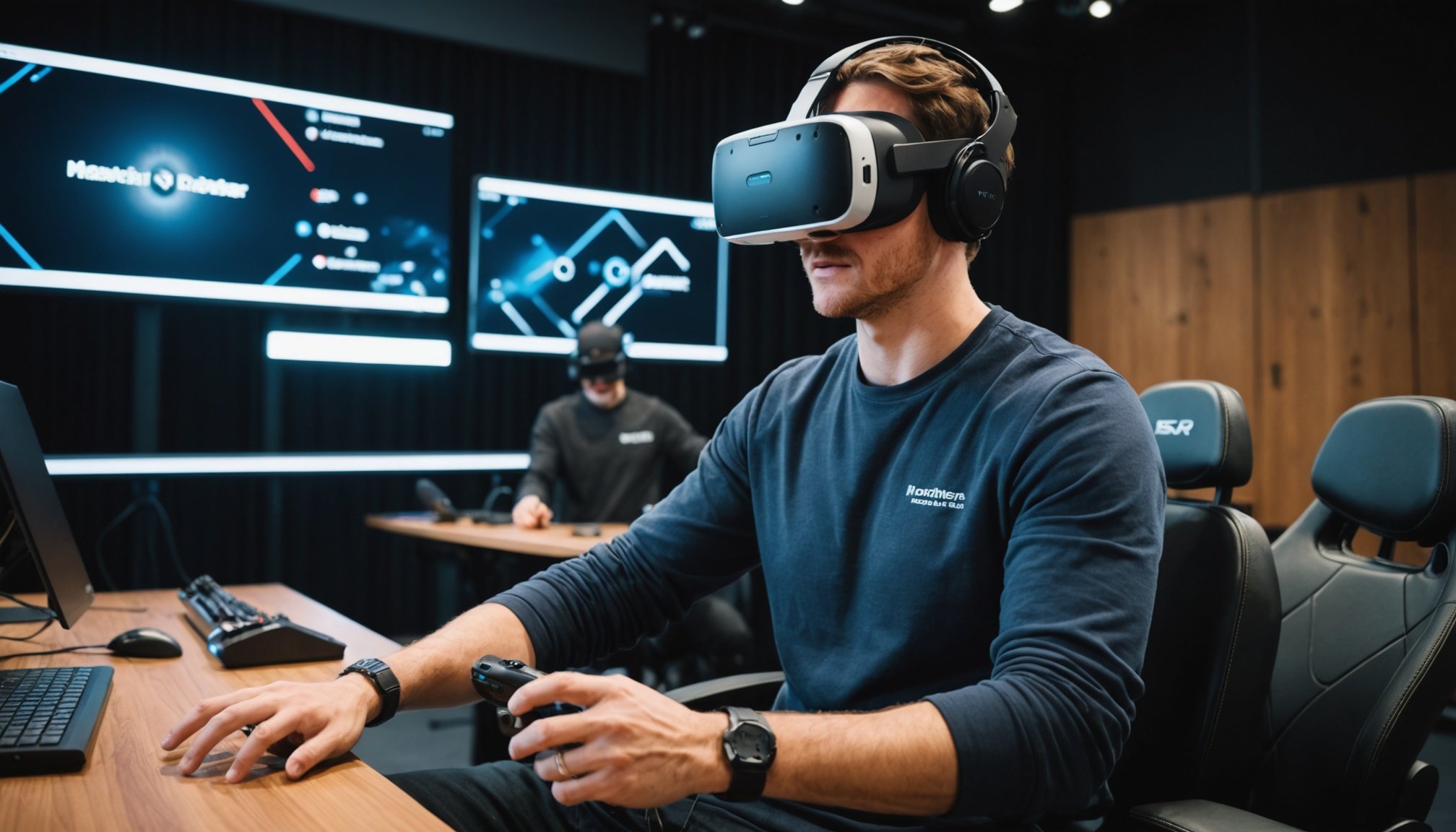Understanding Multiplayer Dynamics in VR Development
Multiplayer dynamics significantly enhance the user experience in virtual reality (VR) environments. By enabling players to engage with both the virtual world and other participants, these dynamics open up new levels of player engagement and sustained interaction.
Key elements that influence VR interactions include the design of the virtual environment, the nature of the tasks, and the complexity of interactions among players. In multiplayer VR games, the inclusion of cooperative and competitive elements can enrich the experience, cultivating a deeper immersion and connection among players.
Have you seen this : Unleashing the power of neural networks: enhancing real-time object recognition in augmented reality gaming
One paramount factor for seamless gameplay is network performance. Any lag or disruptions in connectivity can severely hinder the multiplayer experience, leading to frustrations and diminished satisfaction. Therefore, developers must ensure robust network infrastructures to maintain real-time synchronisation. Enhanced latency management and optimal bandwidth usage are essential in achieving this goal.
Furthermore, understanding player behaviour and preferences is crucial. The integration of responsive feedback mechanisms allows developers to tailor experiences that match varying player engagement levels. As VR technology continues to evolve, the focus on refining multiplayer dynamics will undoubtedly play a pivotal role in shaping future enhancements and innovations in the industry.
Additional reading : Unlocking lush forest landscapes: essential techniques for crafting immersive exploration games
Common Challenges in Developing Multiplayer VR Experiences
Developing multiplayer VR experiences presents various VR development challenges. One primary concern revolves around the technical limitations of current VR hardware, impacting the depth and quality of multiplayer gaming. These limitations may constrain developers aiming to create more immersive worlds, as existing hardware struggles with rendering detailed environments efficiently.
Synchronization problems are another critical issue that developers must address. In multiplayer settings, maintaining consistent and precise gameplay across multiple users is vital for a seamless experience. Any discrepancies can lead to frustrating gameplay, causing players to lose engagement. Ensuring synchronization requires robust solutions, often involving complex coding and advanced algorithms.
Moreover, latency and connection issues pose significant hurdles in the VR development landscape. In multiplayer environments, even minor delays can dramatically impact player interactions and overall gameplay dynamics. Developers must employ strategies to minimize latency, such as optimizing data transmission and utilizing efficient networking protocols, to enhance the user experience.
Addressing these multiplayer issues requires a multifaceted approach, combining innovative software solutions with advancements in VR hardware. As technology evolves, overcoming these challenges will become more manageable, paving the way for richer and more engaging multiplayer VR experiences.
Innovative Solutions to Enhance Multiplayer Dynamics
Designing compelling multiplayer experiences relies heavily on VR solutions and innovative design that captivate and retain players. Developers need to address several aspects to ensure dynamic multiplayer gaming.
Implementing Advanced Networking Techniques
The choice between peer-to-peer and dedicated server models significantly influences gameplay. Peer-to-peer allows direct communication among players, reducing latency but risking stability under heavy loads. In contrast, dedicated servers offer more consistent performance, though they require greater resources. To handle these issues, developers can use simulation techniques for latency compensation. This involves predicting player actions to smooth out gameplay, ensuring uninterrupted fun even when networks falter.
Enhancing User Interface for Multiplayer Engagement
An intuitive user interface (UI) is crucial for seamless player interaction in VR settings, making it easy for users to navigate. Feedback and communication channels are vital; they empower players, enhance involvement, and improve gameplay experience through clear alerts and status updates. Integrating these features into VR can foster a more engaging gaming environment.
Adapting Game Mechanics for Multiplayer Environments
Balanced gameplay is essential to maintain fair competition. Developers should focus on game mechanics that accommodate diverse player abilities while ensuring equality. Encouraging collaboration and teamwork through thoughtful game design nurtures camaraderie among players, making the multiplayer experience not only competitive but also rewarding. These strategies ensure all players feel included and motivated.
Best Practices for Effective Multiplayer VR Design
Creating an engaging multiplayer VR experience requires understanding user motivations and behaviour. Players are driven by various incentives, such as competition, collaboration, or exploration. By identifying these motivations, designers can craft gameplay elements that resonate with diverse player bases.
Developing an inclusive environment is essential to accommodate diverse player communities. Encourage collaboration and friendly competition while ensuring in-game communication tools are accessible to all users, regardless of language or ability. This fosters a sense of belonging, enhancing the overall VR experience.
To maintain relevance and appeal in a constantly evolving landscape, continuously gather and analyse user feedback. Implementing changes based on direct input not only improves gameplay but also builds trust with players, demonstrating an active commitment to refining their experience.
Employing user-centric design principles is fundamental. These principles highlight the importance of multiplayer strategies that focus on accessibility and community building. By putting players at the heart of the design process, developers can ensure a more impactful and engaging game environment for all participants.
Consider the dynamic nature of VR environments, where real-time interaction plays a crucial role. It’s these thoughtful strategies that unlock the true potential of multiplayer VR, creating an ecosystem where players thrive and persist.
Case Studies of Successful Multiplayer VR Experiences
Exploring the realm of multiplayer VR, many case studies reveal the mechanics that make these experiences captivating. Popular games like “Rec Room” and “VRChat” have set benchmarks with their effective multiplayer design, creating immersive worlds that resonate with players globally. Success stories from these platforms highlight the importance of seamless social interaction and accessibility.
Engaging mechanics are central to these VR case studies. For instance, using avatars to express identity encourages player interaction and deepens immersion. Allowing user-generated content in environments like “Rec Room” fosters creativity and community building. These elements are pivotal in crafting successful multiplayer experiences.
On the flip side, lessons from failed projects provide valuable insights. Attempts at using complex control schemes often alienate players, highlighting the necessity for intuitive interfaces. Projects that ignored community feedback or failed to deliver regular updates stagnated quickly.
Identifying trends from these implementations showcases several innovations. Adaptive AI that reacts to player emotions or preferences can enhance gaming experiences. Furthermore, augmented elements such as haptic feedback create a tangible connection between the virtual environment and player.
In conclusion, understanding these case studies and success stories underscores the importance of effective multiplayer design and sets a guiding path for future innovations in the VR landscape.
Expert Perspectives on the Future of Multiplayer VR
Understanding the future trends in multiplayer VR involves engaging with the nuanced viewpoints of industry experts. They elucidate the interplay between evolving technologies and multiplayer dynamics.
Insights from Industry Leaders
Experts assert that emerging technologies like 5G and artificial intelligence will significantly enhance multiplayer VR experiences. These technological advances promise seamless, immersive worlds that feel more interconnected. Looking ahead, industry leaders predict that future VR evolutions might blur boundaries between the virtual and real worlds, facilitating unprecedented interaction scenarios. Enhanced AI could make interactions with non-player characters more lifelike, enriching the overall experience.
The Role of Community in Shaping VR Multiplayer
Player communities are pivotal in guiding VR multiplayer development. Game developers recognise the value these communities provide, often gaining insights into user preferences and possible enhancements. Engaging effectively with users via forums and beta testing helps in understanding evolving player needs and aspirations. Such interaction ensures the development of games that resonate with and are driven by user demand, cementing the importance of community feedback.
Balancing Innovation with User Experience
While innovation is central to VR evolution, maintaining seamless user experience is fundamental. The introduction of new features should not disrupt established gameplay dynamics. Ensuring user-friendliness during significant technological upgrades is essential, combining creative advancements with intuitive designs for optimal satisfaction.






